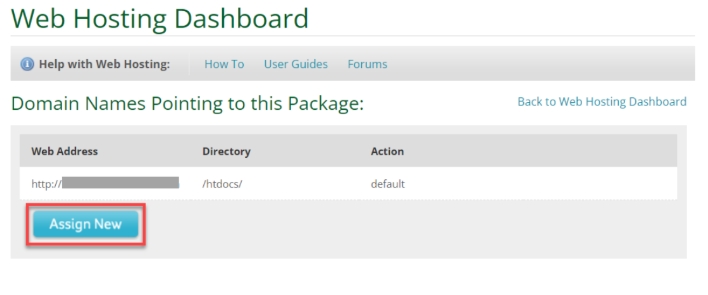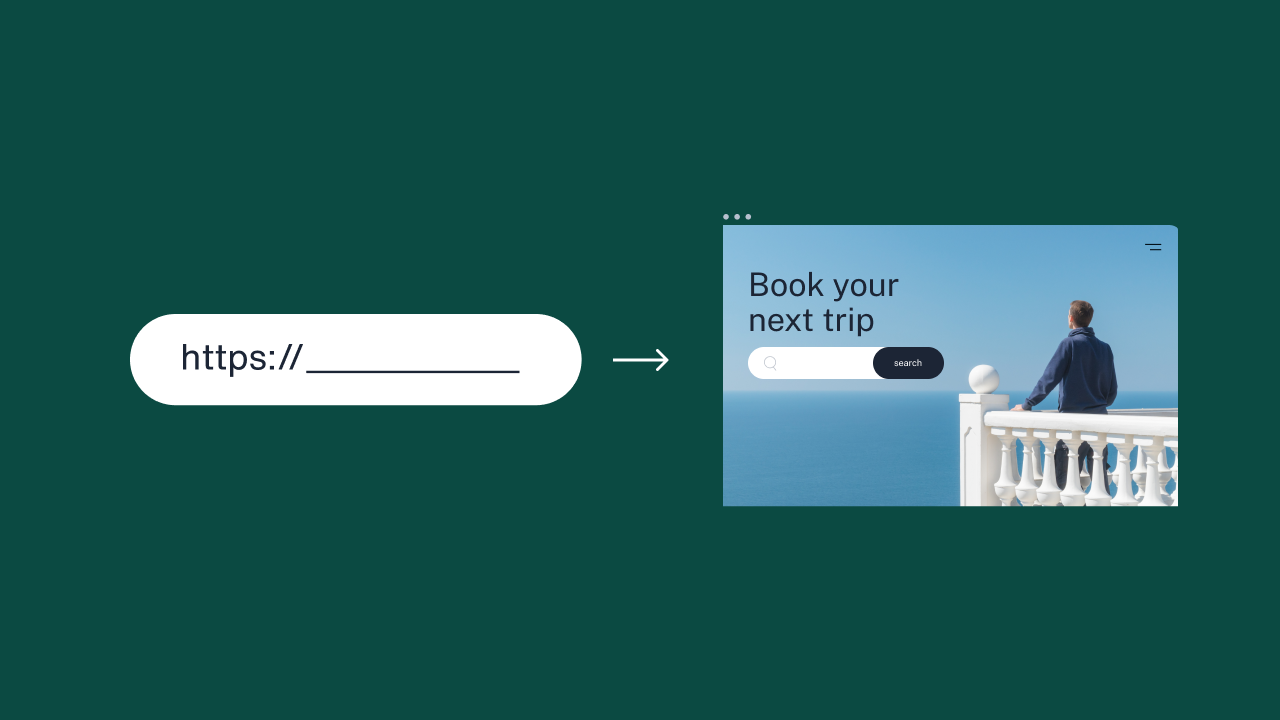Key takeaways:
- Domain pointing connects a domain to a hosting server by updating your Domain Name System (DNS).
- Without domain pointing, your site becomes inaccessible to visitors using your chosen domain name.
- Although domain pointing doesn’t directly impact SEO rankings, it’s a key technical foundation that makes all SEO work possible.
You’ve spent weeks perfecting your small business website: carefully choosing colors, writing copy, and organizing your services. Before launching, you need to perform an important step to ensure that users can access your site: domain pointing.
Domain pointing is one of the most significant foundational steps to establishing your online presence. When your domain is properly set up, your brand efficiently reaches your target market. With 144.68 million registered domains in the United States, it’s best to ensure seamless accessibility that can guide users directly to your site.
Whether you’re launching your first website, migrating to a new hosting provider, or managing multiple domains for your growing business, understanding domain pointing is the key to a seamless, professional online experience and avoiding a frustrating digital dead end.
Let’s dive into everything you need to know about domain pointing.
What is domain pointing
Domain pointing connects a domain to a hosting server by updating your Domain Name System (DNS). Visitors who type your domain name get to the right website. This is done by setting the domain’s DNS to the IP of your web host. In simpler terms, it’s a bridge that connects your domain name to the correct online destination, allowing visitors to access your site easily.
Here’s a simplified explanation of the technical process of domain pointing:
- DNS is like a phone book
- Updates information
- Creates the connection
- Your website appears
DNS is like a phone book
The DNS works like an internet phone book that converts website names like www.website.com into codes like 192.0.2.1 that computers understand. These codes tell computers where to find your website.
Updates information
When you point a domain, you’re basically updating your listing in this internet phone book. You do this through your domain registrar (where you bought your domain name). The two main ways to update are:
- Nameservers. These tell the internet which company is managing your website’s information. You’ll usually change these to match what your web hosting company provides (e.g., ns1.hostingprovider.com). This lets your hosting company handle all the technical stuff.
- A records. This directly connects your website name to your web server’s internet protocol (IP) address. If you don’t change nameservers, you’d update this to point to your hosting company’s server address.
Creates the connection
By updating these settings, you create a direct path from your domain name to your website. When someone types your website address, the DNS system looks it up, finds your updated information, and sends them to the right place.
Your website appears
Your web server then shows your website to the visitor, making everything work smoothly.
What makes domain pointing important
Without domain pointing, your domain is practically “useless”, since your site becomes inaccessible to visitors, meaning no one can find or browse your website using your chosen domain name. But its importance extends far beyond just website accessibility. Here are reasons why domain pointing is important:
- Brand identification
- Search engine optimization (SEO)
- Flexibility and control
Let’s explore what truly makes this procedure vital.
Brand identification
Your domain name is your company’s online identity. Domain pointing ensures customers find your business through its own web address instead of random numbers or generic hosting subdomains. This is key to credibility, brand recognition, and professionalism. You can also get branded email addresses like [email protected], which is a bonus to your professionalism.
Search engine optimization (SEO)
Although domain pointing doesn’t directly impact SEO rankings, it’s a key technical foundation that makes all SEO work possible. Search engine bots (automated programs for exploring and discovering new pages) need to reach and scan your website’s content to include it in search results.
When your domain isn’t properly connected, search engines can’t access your site, making it completely invisible online. Correct domain pointing guarantees reliable availability and accessibility, which are vital for preserving search rankings and ensuring your website can be found.
Flexibility and control
Domain pointing provides you with considerable flexibility over your web presence. It lets you purchase your domain name from one company (domain registrar) while storing your website files with an entirely different provider (web host). This separation means you can select the top registrar for domain services and the best website host for website performance, without being tied to a single company.
It also simplifies moving your website to a new hosting provider later by just changing the pointing settings.
When is domain pointing relevant?
- Launching a new website. When you create a new website, first create a checklist that covers content, functionality, and design. Then point your domain name to the web host server to ensure that your new website is accessible online. The web host server is where your website files are hosted.
- Switching hosting providers. If you’ve chosen a new hosting provider, practice caution when moving your website. You must update your domain’s pointing settings to reflect the new server location and avoid disruptions. This ensures smooth migration by verifying DNS changes.
- Using multiple domains for the same website. You might want to use different domain names (e.g., .com, .net) for the same website. Domain pointing allows you to direct all those domains to your website.
- Maintaining different websites on one hosting account. If multiple websites are hosted on a single hosting account, domain pointing helps direct each domain name to the correct website.
Who is domain pointing for?
Domain pointing is for anyone who has a domain name and wants to connect it to a specific web hosting service where their website’s files will be stored. This includes the following.
- Website owners. Ensures your site remains accessible, especially when changing hosting providers. This applies regardless of whether you’re launching a new site or performing a full website migration.
- Bloggers. Maintains consistent branding and accessibility as your blog grows. For blogging, effective and efficient domain management contributes to consistent online presence.
- eCommerce stores. Keeps your online store operational and accessible during website migrations or updates.
- Freelancers and professionals. It helps maintain a professional website that makes personal brand more searchable by seamlessly directing your domain to your portfolio or service site.
- Multiple brand owners. Allows businesses managing multiple brands or websites to efficiently direct each domain to its respective site.
Anyone who needs their website to be accessible by using a personal or business domain name will need to understand domain pointing so their site is reachable online.
What are domain pointing best practices?
- Choose reputable providers. Choose a trustworthy domain registrar and web hosting company that are known for consistent uptime, robust security, and excellent customer service. The quality of their infrastructure directly affects how stable and fast your domain performs.
- Distinguishing domain pointing from domain transferring. It’s important to understand the difference between these two processes. Domain pointing directs your domain to a new server without changing its registrar, while domain transferring moves your domain registration to a new registrar entirely. It’s only important you pick the method that fits your needs.
- Verify DNS records. When configuring or updating pointing, verify all DNS entries, particularly Nameserver details and A records information. Just one typing error can cause your site to go offline.
- Enable Domain Name System Security Extensions (DNSSEC). This provides an important security layer by digitally signing your DNS information, safeguarding your domain against DNS hijacking and poisoning attacks that could send visitors to harmful websites.
- Enable domain locking. This blocks unauthorized domain transfers, providing crucial protection against domain theft. For high-value domains, consider implementing Registry Lock for maximum security protection.
- Back up your files. If you’re switching hosting providers, it’s always a good idea to back up your website files and databases first. This way, you’ve saved a copy of your website’s data in case the pointing process goes wrong.
- Migrate during low-traffic periods. When changing hosting providers, plan your domain pointing updates during your website’s lowest traffic periods. Consider posting a brief notification on your site to let visitors know about possible temporary downtime.
How to perform domain pointing with Network Solutions
Domain pointing sounds technical, but it’s a simple process that you can perform with the right guidance. This step-by-step guide eliminates the guesswork, allowing you to correctly perform the said procedure.
- Access your Network Solutions account at https://www.networksolutions.com/my-account/login.
- Select Hosting from the left-hand menu.

- If your account contains several hosting packages, select “Manage” beside the specific package you wish to work with.
After entering your Web Hosting Control Panel, navigate to Assign/Edit Your Domain.
- Click Assign New.

- Choose a domain from the Select a Domain dropdown menu and click “Select.”
- If your domain doesn’t appear in the list, choose –Add domain not listed, then click Select. Enter the domain name manually and click Select. Make sure to follow the displayed instructions to properly configure your DNS settings to direct traffic to your site.
- If you haven’t registered a domain yet, you can buy and register one by clicking “Buy More Products” at the bottom left navigation menu. After registering the domain, return to the beginning of step 2.
- Use the /htdocs (UNIX) or /www (Windows) dropdown to choose your preferred folder. This dropdown displays all available folders found on the server. To create a new folder, select – Add directory not listed, then click Select. Enter your desired folder or directory name, then click Select.
- Follow the prompts to complete.
Note: The root directory represents the top-level folder within a hosting package. For our hosting services, this is the most accessible directory where you have read and write permissions.
Unix Hosting
For users who have Unix Hosting, the root is: /htdocs

Windows Hosting
For users who have Windows Hosting, the root is: /www

What are domain pointing alternatives?
Domain pointing is just one aspect of domain pointing, and there are other alternatives like domain transferring and forwarding that help in effective domain management. Understanding their differences is important.
| Domain pointing | Domain transferring | Domain forwarding | |
| What it does | Links your domain name to a web server (hosting service). | Transfers your domain’s registration from one registrar to a different one. | Routes visitors from one domain name to another web address. |
| Primary purpose | Puts your website online and makes it available to visitors. | Transfers domain registration management and billing to a different party. | Directs visitors from a secondary or outdated domain to your main website. |
| Action taken | Modifies DNS records (such as Nameservers or A Records) with your existing registrar. | Begins the transfer procedure between registrars, usually requiring an authorization code (EPP code). | Sets up a redirect (such as 301 or 302) in your domain’s DNS configuration to forward traffic to another URL. |
| Registrar | Stays the same. | Changes. | Remains unchanged (the registration location of the forwarding domain). |
| Hosting | Necessary to activate the domain; the domain directs to hosting services. | Not directly impacted but frequently performed alongside hosting modifications. | The domain being forwarded doesn’t require hosting in order for the redirect to function. |
| Ownership | Remains with the existing owner. | Remains under the existing owner’s control, but administration transfers to a different registrar. | Remains with the existing owner. |
| SEO impact | Important foundation: Guarantees crawlability and accessibility. SEO is impossible without it. | Limited direct effect on SEO, but assists in streamlining management. | Major SEO impact: Needs correct 301 redirects to transfer “link equity” and prevent duplicate content problems. |
Point your domain right: Maximize your online presence with Network Solutions
Domain pointing is the key to your online success, but managing it right requires expertise, innovative tools, and ongoing support. While the basics seem easy, the technical complexities and risks of misconfiguration can cost you traffic, credibility, and revenue.
Ready to secure your domain and optimize your online presence? Network Solutions offers comprehensive domain management tools and expert support to ensure your domain pointing is configured correctly and maintained reliably.
Frequently asked questions
Domain pointing, or DNS propagation, usually takes 24 to 48 hours to work completely worldwide, though it can occasionally take up to 72 hours. Often, particularly with fast DNS providers and shorter cache times, changes can happen much quicker—sometimes within minutes or just a few hours. How long it takes depends on factors like your internet provider’s settings, your domain’s registry system, and which DNS servers are handling the change.
No, you can’t point the same main domain to different places at once. Instead, you have two main options: point several domain names to one main website (where all your different domains send visitors to the same site), or create subdomains (like blog.yourbusiness.com or shop.yourbusiness.com) where each section can connect to different servers or applications.
To verify your domain pointing is correct, confirm your domain resolves to your hosting provider’s IP address or nameservers. Use DNS lookup tools like What’s My DNS or DNS Checker to check if global servers show consistent results.
Test by accessing your website in a browser with cleared cache or on a different device. Technical users can use nslookup or dig commands. If pointing is incorrect, check DNS settings for errors, wait for propagation, flush local DNS cache, or contact your hosting provider or registrar for support.




